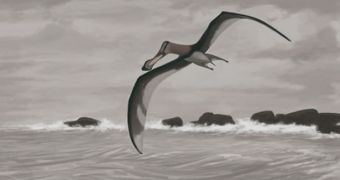Wind tunnel tests reveal that the enormous pterosaurs, also called pterodactyls, flew with most ease and efficiency carried by slight, warm breezes at the tropics. These conditions allowed them to glide for long distances, and did not hinder their landing.
This was a very important factor for these flying lizards, which had very fragile bones, flexible bodies and paper-thin wings. Under optimal conditions, they were able to land smoothly, which decreased risk of injury considerably.
Thermally-driven air currents were the pterosaurs' main method of locomotion. They weren't at all comfortable in flying carried by strong air currents, such as the ones modern albatrosses use.
Researchers at the University of Bristol reached this conclusion after School of Earth Sciences engineer and paleontology PhD student Colin Palmer constructed a model of the creature's wings.
The synthetic wings were made of thin and curved sheets of epoxy resin/carbon fiber composites, respecting the make-up that was derived after careful studies of pterodactyl fossils.
Those investigations painted the image of a slow and flexible animal, that could not stand being thrown around in the air by strong air currents. This is due in part to the variable geometry of their wings.
In the wind tunnel experiments, the 2D traits of pterosaur's wings was analyzed for the first time ever. The main finding is that the creature was not as aerodynamically efficient as first thought.
“Pterosaur wings were adapted to a low-speed flight regime that minimizes sink rate. This regime is unsuited to marine style dynamic soaring adopted by many seabirds which requires high flight speed coupled with high aerodynamic efficiency, but is well suited to thermal/slope soaring,” Palmer says.
“The low sink rate would have allowed pterosaurs to use the relatively weak thermal lift found over the sea,” the investigator adds.
“Since the bones of pterosaurs were thin-walled and thus highly susceptible to impact damage, the low-speed landing capability would have made an important contribution to avoiding injury and so helped to enable pterosaurs to attain much larger sizes than extant birds,” he explains.
But the expert adds that this also came with a trade-off. The pterosaur “would have been [at] an extreme vulnerability to strong winds and turbulence, both in flight and on the ground, like that experienced by modern-day paragliders.”
The research, which was conducted in collaboration with experts from the UB Department of Aerospace Engineering, is detailed in a paper published on November 24 in the top scientific journal Proceedings of the Royal Society B.

 14 DAY TRIAL //
14 DAY TRIAL //